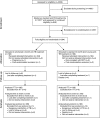Shortening treatment in adults with noncavitary tuberculosis and 2-month culture conversion
- PMID: 19542476
- PMCID: PMC2742745
- DOI: 10.1164/rccm.200904-0536OC
Shortening treatment in adults with noncavitary tuberculosis and 2-month culture conversion
Abstract
Rationale: Cavitary disease and delayed culture conversion have been associated with relapse. Combining patient characteristics and measures of bacteriologic response might allow treatment shortening with current drugs in some patients.
Objectives: To assess whether treatment could be shortened from 6 to 4 months in patients with noncavitary tuberculosis whose sputum cultures converted to negative after 2 months.
Methods: This study was a randomized, open-label equivalence trial. HIV-uninfected adults with noncavitary tuberculosis were treated daily with isoniazid, rifampin, pyrazinamide, and ethambutol for 2 months, followed by 2 months of isoniazid and rifampin. After 4 months, patients with drug-susceptible TB whose sputum cultures on solid media were negative after 8 weeks of treatment were randomly assigned to continue treatment for 2 more months or to stop treatment. Patients were followed for relapse for 30 months after beginning treatment.
Measurements and main results: Enrollment was stopped by the safety monitoring committee after 394 patients were enrolled due to apparent increased risk for relapse in the 4-month arm. A total of 370 patients were eligible for per protocol analysis. Thirteen patients in the 4-month arm relapsed, compared with three subjects in the 6-month arm (7.0 vs. 1.6%; risk difference, 0.054; 95% confidence interval with Hauck-Anderson correction, 0.01-0.10).
Conclusion: Shortening treatment from 6 to 4 months in adults with noncavitary disease and culture conversion after 2 months using current drugs resulted in a greater relapse rate. The combination of noncavitary disease and 2-month culture conversion was insufficient to identify patients with decreased risk for relapse.
Figures


Similar articles
-
Electronic pillbox-enabled self-administered therapy versus standard directly observed therapy for tuberculosis medication adherence and treatment outcomes in Ethiopia (SELFTB): protocol for a multicenter randomized controlled trial.Trials. 2020 May 5;21(1):383. doi: 10.1186/s13063-020-04324-z. Trials. 2020. PMID: 32370774 Free PMC article.
-
Substitution of ethambutol with linezolid during the intensive phase of treatment of pulmonary tuberculosis: study protocol for a prospective, multicenter, randomized, open-label, phase II trial.Trials. 2017 Feb 13;18(1):68. doi: 10.1186/s13063-017-1811-0. Trials. 2017. PMID: 28193240 Free PMC article. Clinical Trial.
-
A controlled clinical trial of oral short-course regimens in the treatment of sputum-positive pulmonary tuberculosis. Tuberculosis Research Centre.Int J Tuberc Lung Dis. 1997 Dec;1(6):509-17. Int J Tuberc Lung Dis. 1997. PMID: 9487448 Clinical Trial.
-
[Effectiveness and problems of PZA-containing 6-month regimen for the treatment of new pulmonary tuberculosis patients].Kekkaku. 2001 Jan;76(1):33-43. Kekkaku. 2001. PMID: 11211781 Review. Japanese.
-
Unilateral and painless development of isoniazid induced gynecomastia during re-treatment of pulmonary tuberculosis.J Assoc Physicians India. 2011 Nov;59:733-5. J Assoc Physicians India. 2011. PMID: 22616343 Review.
Cited by
-
Treatment of Drug Susceptible Pulmonary Tuberculosis.Tuberc Respir Dis (Seoul). 2015 Jul;78(3):161-7. doi: 10.4046/trd.2015.78.3.161. Epub 2015 Jun 30. Tuberc Respir Dis (Seoul). 2015. PMID: 26175767 Free PMC article. Review.
-
Metronidazole prevents reactivation of latent Mycobacterium tuberculosis infection in macaques.Proc Natl Acad Sci U S A. 2012 Aug 28;109(35):14188-93. doi: 10.1073/pnas.1121497109. Epub 2012 Jul 23. Proc Natl Acad Sci U S A. 2012. PMID: 22826237 Free PMC article.
-
Geographic differences in time to culture conversion in liquid media: Tuberculosis Trials Consortium study 28. Culture conversion is delayed in Africa.PLoS One. 2011 Apr 11;6(4):e18358. doi: 10.1371/journal.pone.0018358. PLoS One. 2011. PMID: 21494548 Free PMC article. Clinical Trial.
-
Keeping phase III tuberculosis trials relevant: Adapting to a rapidly changing landscape.PLoS Med. 2019 Mar 22;16(3):e1002767. doi: 10.1371/journal.pmed.1002767. eCollection 2019 Mar. PLoS Med. 2019. PMID: 30901331 Free PMC article. Review.
-
Month 2 culture status and treatment duration as predictors of recurrence in pulmonary tuberculosis: model validation and update.PLoS One. 2015 Apr 29;10(4):e0125403. doi: 10.1371/journal.pone.0125403. eCollection 2015. PLoS One. 2015. PMID: 25923700 Free PMC article.
References
-
- Dutt A, Moers D, Stead WW. Smear- and culture-negative pulmonary tuberculosis: four-month short course chemotherapy. Am Rev Respir Dis 1989;139:867–870. - PubMed
-
- Hong Kong Chest Service/Tuberculosis Research Centre Madras/British Medical Research Council. A controlled trial of 2-month, 3-month, and 12-month regimens of chemotherapy for sputum smear-negative pulmonary tuberculosis: the results at 30 months. Am Rev Respir Dis 1981;124:138–142. - PubMed
-
- Teo SK, Tan KK, Khoo TK. Four-month chemotherapy in the treatment of smear-negative pulmonary tuberculosis: results at 30 to 60 months. Ann Acad Med Singapore 2002;31:175–181. - PubMed
-
- Hong Kong Chest Service/Tuberculosis Research Centre Madras/British Medical Research Council. A controlled trial of 3-month, 4-month, and 6-month regimens of chemotherapy for sputum-smear-negative pulmonary tuberculosis: results at 5 years. Am Rev Respir Dis 1989;139:871–876. - PubMed
-
- Balasubramanian R, Sivasubramanian S, Vijayan VK, Ramachandran R, Jawahar MS, Paramasivan CN, Selvakumar N, Somasundaram PR. Five year results of a 3-month and two 5-month regimens for the treatment of sputum-positive pulmonary tuberculosis in south India. Tubercle 1990;71:253–258. - PubMed
Publication types
MeSH terms
Substances
Grants and funding
LinkOut - more resources
Full Text Sources
Other Literature Sources
Medical

